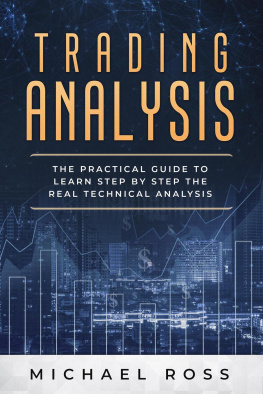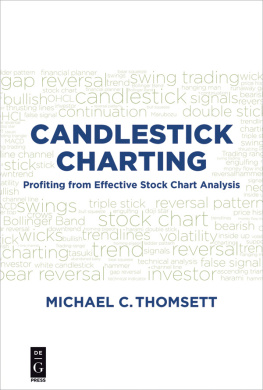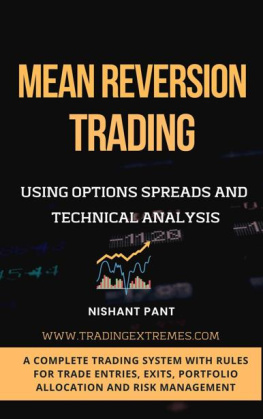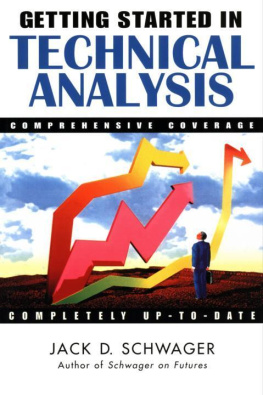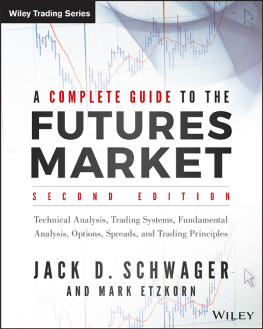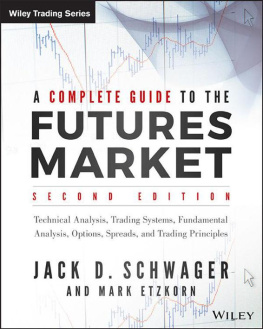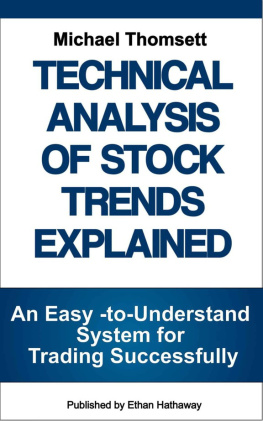CONTENTS
T RADING O PTIONS
Founded in 1807, John Wiley & Sons is the oldest independent publishing company in the United States. With offices in North America, Europe, Australia, and Asia, Wiley is globally committed to developing and marketing print and electronic products and services for our customers' professional and personal knowledge and understanding.
The Wiley Trading series features books by traders who have survived the market's ever changing temperament and have prosperedsome by reinventing systems, others by getting back to basics. Whether a novice trader, professional, or somewhere in-between, these books will provide the advice and strategies needed to prosper today and well into the future.
For a list of available titles, visit our website at www.WileyFinance.com.
T RADING
O PTIONS
Using Technical Analysis to Design
Winning Trades
Greg Harmon

Cover image: Barsoom Design
Cover design: Barsoom Design
Copyright 2014 by Greg Harmon. All rights reserved.
Published by John Wiley & Sons, Inc., Hoboken, New Jersey.
Published simultaneously in Canada.
All charts used with permission from TradingView. All rights reserved.
No part of this publication may be reproduced, stored in a retrieval system, or transmitted in any form or by any means, electronic, mechanical, photocopying, recording, scanning, or otherwise, except as permitted under Section 107 or 108 of the 1976 United States Copyright Act, without either the prior written permission of the Publisher, or authorization through payment of the appropriate per-copy fee to the Copyright Clearance Center, Inc., 222 Rosewood Drive, Danvers, MA 01923, (978) 750-8400, fax (978) 646-8600, or on the Web at www.copyright.com . Requests to the Publisher for permission should be addressed to the Permissions Department, John Wiley & Sons, Inc., 111 River Street, Hoboken, NJ 07030, (201) 748-6011, fax (201) 748-6008, or online at www.wiley.com/go/permissions .
Limit of Liability/Disclaimer of Warranty: While the publisher and author have used their best efforts in preparing this book, they make no representations or warranties with respect to the accuracy or completeness of the contents of this book and specifically disclaim any implied warranties of merchantability or fitness for a particular purpose. No warranty may be created or extended by sales representatives or written sales materials. The advice and strategies contained herein may not be suitable for your situation. You should consult with a professional where appropriate. Neither the publisher nor author shall be liable for any loss of profit or any other commercial damages, including but not limited to special, incidental, consequential, or other damages.
For general information on our other products and services or for technical support, please contact our Customer Care Department within the United States at (800) 762-2974, outside the United States at (317) 572-3993, or fax (317) 572-4002.
Wiley publishes in a variety of print and electronic formats and by print-on-demand. Some material included with standard print versions of this book may not be included in e-books or in print-on-demand. If this book refers to media such as a CD or DVD that is not included in the version you purchased, you may download this material at http://booksupport.wiley.com . For more information about Wiley products, visit www.wiley.com .
Library of Congress Cataloging-in-Publication Data:
Harmon, Greg.
Trading options : using technical analysis to design winning trades / Greg Harmon.
pages cm. (Wiley trading series)
Includes index.
ISBN 978-1-118-67913-5 (hardcover); ISBN 978-1-118-67912-8 (ePDF);
ISBN 978-1-118-67917-3 (ePub)
1. Technical analysis (Investment analysis) 2. Investments. 3. Speculation. I. Title.
HG4529.H366 2014
332.64'53dc23
2013039744
I wish to dedicate this book to my lovely wife, Christine.
Without her love, support and encouragement
it never would have happened. And to our two budding
young technical analysts, Drew and Bronwyn,
ever supportive and always learning.
FOREWORD
T he subject of this wonderful book is options, and its theme is technical analysis. Greg Harmon deftly describes and teaches us that the commonality in both subjects is price . The laws of supply and demand, or, said another way, the interactions between buyers and sellers, dictate what the trends and the patterns of price will be. Trading Options goes on to meld these trends and patterns into a top-down and bottom-up approach to trading. The macro or top-down view starts with an index and works its way through a sector, intermarket relationships (e.g., fixed income, commodities, etc.), and then to individual stocks. Conversely, the micro or bottom-up approach commences with a single issue and wends its way through intermarket factors, corresponding sectors, and, ending with a market overview, via an index. This is by far the most efficient way to cover the market and identify new optionable ideas.
In price there is knowledge . One trades differently whether in a bullish or in a bearish trend; for example, certain distinct price and volume patterns manifest themselves in a bull market whereas quite often the exact opposite occurs within a bear trend. The early pages of this book help identify these distinctions. The timing of purchases and sales is only part of the task required to be a successful trader; the second and equally important consideration is risk managementwhen and where to take small losses.
The universality of technical analysis comes alive in this book: Greg emphasizes ratio charts that cover a broad array of topicsfor example, emerging markets, U.S. Treasuries, and silver/gold; they instantly expand one's horizons and take the reader around the globe. Nowhere is there a worldwide language as comprehensive and as easily accessible as the charting of prices. This book should be mandatory reading for anyone interested in options and its mutually interdependent subject, technical analysis.
Trading Options also provides the reader with an integrated system of critical disciplines starting with classical technical analysis with its ability to identify trends and myriad important price patterns. Then it layers on top of this foundation candlestick charting with its unique series of key reversals; indicators like the Relative Strength Index (RSI) are used to create a baseline of future strength and weakness. Last, it gleans areas of potential buyers (support zones) and potential sellers (resistance zones) along with meaningful price objectives by using Fibonacci retracements along with Elliott Wave principles and Harmonics. This carefully laid out technical tapestry is the mosaic that provides readers with the ingredients needed to create their watch lists and plans of action.
Now, the operative word is change . Greg Harmon insists, and rightly so, that positions should be initiated when prices actually break above resistance or below support levelshe refers to this phenomenon as triggers. And when triggers occur, you must apply the correct option strategy. Here is where the book once again truly adds value: It explains in-the-money, at-the-money, and out-of-the-money options and how they consist of intrinsic value and time value, along with 13 different combinations of puts and calls. He then combines the concepts of the driver, funding option, and risk limiter into a trading plan . And he finalizes everything with the execution and adjustments for profit taking and hedging.
I wholeheartedly endorse Trading Options because it encourages a set of disciplines that are so important in any kind of trading; for example, it cautions that prejudging triggers can often lead to an incorrect call. Now, that's very sound advice!
Next page

